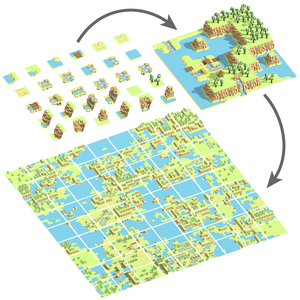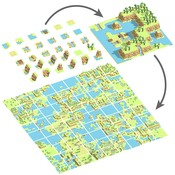Information
- Publication Type: Bachelor Thesis
- Workgroup(s)/Project(s):
- Date: January 2019
- Date (Start): December 2017
- Date (End): January 2019
- Matrikelnummer: 01527434
- Note: 1
- First Supervisor: Bernhard Steiner
- Keywords: procedural modelling, model synthesis, terrain generation
Abstract
In recent years, procedural content generation became a valuable tool to create virtual
experiences. In a multitude of computer graphics applications, it aids designers to
generate vast, detailed worlds. Previous methods for procedural content generation, for
example, terrain generation, only cover certain distinct domains where highly specialized
algorithms are used. These specialized algorithms can only be configured by programmers
or artists with a technical background. With a new approach to procedural generation,
called Model Synthesis, it is possible to generate a variety of content, like textures or
models with a general purpose algorithm that can be configured by users without domainspecific
knowledge of grammars or logical expressions. In this thesis, a proof-of-concept
implementation is created to show how this new algorithmic approach can be utilized
to generate infinite terrains. A widely used Model Synthesis algorithm named Wave
Function Collapse is incorporated into a system providing the complete pipeline needed
for the use in a production environment. This pipeline starts with processing of the
input: three-dimensional blocks of geometry called tiles. In the terrain generation, they
are placed in a lattice such that their geometry matches with the neighboring ones. To
create this matching information, the developed system analyzes the geometry of the tiles
to generate neighborhood constraints. The terrain generator then uses this information
to solve small patches of terrain with instances of the Wave Function Collapse algorithm.
Merging these patches to an arbitrary large terrain that can be extended on runtime is
also achieved with the developed system.
Additional Files and Images
Additional images and videos
Additional files
Weblinks
No further information available.
BibTeX
@bachelorsthesis{scholz_2017_bac,
title = "Tile-Based Procedural Terrain Generation",
author = "Dominik Scholz",
year = "2019",
abstract = "In recent years, procedural content generation became a
valuable tool to create virtual experiences. In a multitude
of computer graphics applications, it aids designers to
generate vast, detailed worlds. Previous methods for
procedural content generation, for example, terrain
generation, only cover certain distinct domains where highly
specialized algorithms are used. These specialized
algorithms can only be configured by programmers or artists
with a technical background. With a new approach to
procedural generation, called Model Synthesis, it is
possible to generate a variety of content, like textures or
models with a general purpose algorithm that can be
configured by users without domainspecific knowledge of
grammars or logical expressions. In this thesis, a
proof-of-concept implementation is created to show how this
new algorithmic approach can be utilized to generate
infinite terrains. A widely used Model Synthesis algorithm
named Wave Function Collapse is incorporated into a system
providing the complete pipeline needed for the use in a
production environment. This pipeline starts with processing
of the input: three-dimensional blocks of geometry called
tiles. In the terrain generation, they are placed in a
lattice such that their geometry matches with the
neighboring ones. To create this matching information, the
developed system analyzes the geometry of the tiles to
generate neighborhood constraints. The terrain generator
then uses this information to solve small patches of terrain
with instances of the Wave Function Collapse algorithm.
Merging these patches to an arbitrary large terrain that can
be extended on runtime is also achieved with the developed
system.",
month = jan,
note = "1",
address = "Favoritenstrasse 9-11/E193-02, A-1040 Vienna, Austria",
school = "Research Unit of Computer Graphics, Institute of Visual
Computing and Human-Centered Technology, Faculty of
Informatics, TU Wien ",
keywords = "procedural modelling, model synthesis, terrain generation",
URL = "https://www.cg.tuwien.ac.at/research/publications/2019/scholz_2017_bac/",
}

 thesis
thesis
